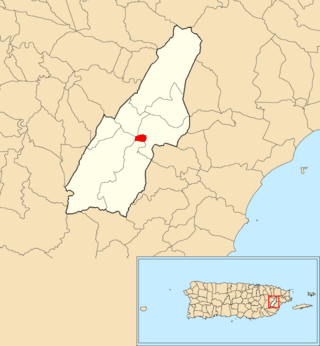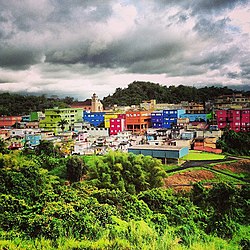
Bayamón barrio-pueblo is a barrio and the administrative center (seat) of Bayamón, a municipality of Puerto Rico. Its population in 2010 was 4,746.

Coamo barrio-pueblo is a barrio and the administrative center (seat) of Coamo, a municipality of Puerto Rico. Its population in 2010 was 6,685.

Barceloneta barrio-pueblo is a barrio and the administrative center (seat) of Barceloneta, a municipality of Puerto Rico. Its population in 2010 was 435.

Yauco barrio-pueblo is a barrio and the administrative center (seat) of Yauco, a municipality of Puerto Rico. Its population in 2010 was 3,091.

Peñuelas barrio-pueblo is a barrio and the administrative center (seat) of Peñuelas, a municipality of Puerto Rico. Its population in 2010 was 1,422.

Camuy barrio-pueblo is a barrio and the administrative center (seat) of Camuy, a municipality of Puerto Rico. Its population in 2010 was 3,354.

Guánica barrio-pueblo is a barrio and the administrative center (seat) of Guánica, a municipality of Puerto Rico. Its population in 2010 was 3,514.

Jayuya barrio-pueblo is a barrio and the administrative center (seat) of Jayuya, a municipality of Puerto Rico. Its population in 2010 was 1,222.

Moca barrio-pueblo is a barrio and the administrative center (seat) of Moca, a municipality of Puerto Rico. Its population in 2010 was 1,735.

Salinas barrio-pueblo is a barrio and the administrative center (seat) of Salinas, a municipality of Puerto Rico. Its population in 2010 was 2,453.

Santa Isabel barrio-pueblo is a barrio and the administrative center (seat) of Santa Isabel, a municipality of Puerto Rico. Its population in 2010 was 5,133.

Utuado barrio-pueblo is a barrio and the administrative center (seat) of Utuado, a municipality of Puerto Rico. Its population in 2010 was 5,856.

Mayagüez barrio-pueblo is a barrio and the administrative center (seat) of Mayagüez, a municipality of Puerto Rico. Its population in 2010 was 26,903.

Guayama barrio-pueblo is a barrio and the administrative center (seat) of Guayama, a municipality of Puerto Rico. Its population in 2010 was 16,891.

Juana Díaz barrio-pueblo is a barrio and the administrative center (seat) of Juana Díaz, a municipality of Puerto Rico. Its population in 2010 was 3,977.

Lajas barrio-pueblo is a barrio and the administrative center (seat) of Lajas, a municipality of Puerto Rico. Its population in 2010 was 564.

Las Piedras barrio-pueblo is a barrio and the administrative center (seat) of Las Piedras, a municipality of Puerto Rico. Its population in 2010 was 1,500.

Trujillo Alto barrio-pueblo is a barrio and the administrative center (seat) of Trujillo Alto, a municipality of Puerto Rico. Its population in 2010 was 673.

San Germán barrio-pueblo is a barrio and the administrative center (seat) of San Germán, a municipality of Puerto Rico. Its population in 2010 was 2,660.

Luquillo barrio-pueblo is a barrio and the administrative center (seat) of Luquillo, a municipality of Puerto Rico. Its population in 2010 was 1,028.
























